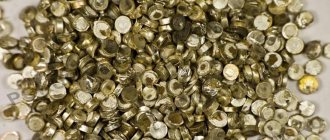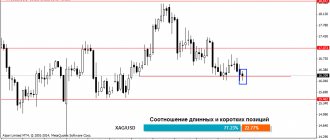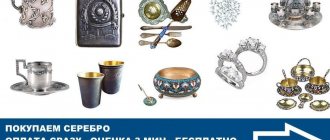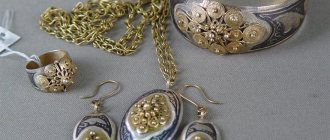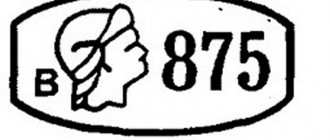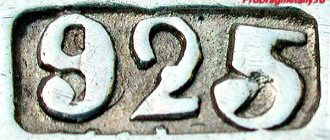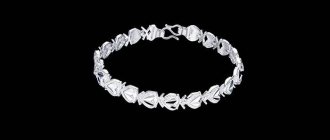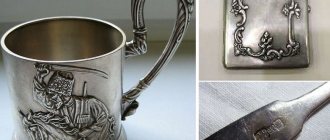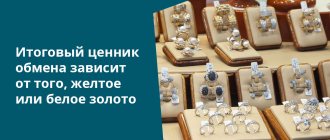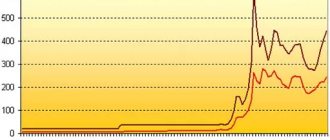Good day! Let's talk about a type of silver that you won't find in boxes among precious stones, but can be found where there is electrical equipment - that is, almost everywhere. This is technical silver.
Unlike gold, which is considered primarily a jewelry and investment precious metal, silver is widely in demand in industry. It is used in the manufacture of:
- wires;
- batteries;
- contacts;
- wires;
- solders and much more.
A huge amount of silver of varying purity is found around us in the form of grains, thin films, scrap and sputtering. Its volume is tens or even hundreds of times greater than the volume of metal that we wear in the form of jewelry.
What kind of silver is this
Strictly speaking, there is no such type of silver as “technical”. This is the name given to any silver alloy used not in jewelry, but in production.
Composition and properties
The main alloying component in a jewelry alloy is copper. The technical range is wider: cadmium, zinc, tin, nickel, and aluminum may be present. Their proportions are calculated based on the desired result.
Cadmium, zinc and tin lower the melting point, which makes alloys containing them valuable solders. True, cadmium makes the product more expensive, and zinc negatively affects its strength, so there are no universal solders - the composition is selected individually for the task.
Iron will not combine with Ag into a homogeneous mass and is considered an undesirable impurity.
Strength
Strength is also determined by the composition of the alloy. Some metals significantly increase the fragility of silver, and they are not alloyed with them or are introduced to a limited extent. This:
- lead;
- aluminum;
- tin (with a content of more than 9%);
- zinc (with a content of more than 14%).
What is the standard of this silver?
The purity of the alloy varies depending on the function it performs. “Magnetic technical silver” used in contact plates, buttons and switches is 60-65% pure - that's 600-650 fineness in the metric system. It is low-grade enough for the introduced ligature to exhibit magnetic properties.
“Non-magnetic technical silver” with a purity of 80–85% is a precious metal of 800–850 fineness, close to 875, which is used everywhere, although it is inferior in popularity to 925 fineness for jewelry. Solders are made from alloys, the fineness of which can be 400, 600, 620, 700 - in general, any number of metric units.
What stands apart in this series is the galvanic coating, which is used to silver the parts. Due to the peculiarities of the technological process, such metal can only be purest - 999 fine. The film on the product obtained as a result of electrolytic action is so thin that it is difficult to remove and remelt. Thickness is measured in microns (µm) - thousandths of a millimeter.
Technical silver sample
The exact hallmark depends on the type and function of the silver:
- Magnetic . Used in switches, contact plates. The purity of silver is at the level of 60-65%, which corresponds to a sample of 600-650.
- Non-magnetic . Much purer silver, reaching 80%, or 800 purity. Most often, radio components are purchased for precisely this precious metal. The close proximity to jewelry grade 875 makes the silver suitable for melting down.
Galvanic coating deserves special attention. Often, the purchase of radio components is done for the sake of extracting this metal, which is exclusively 999-grade. The problem is the size. The film thickness is only a few microns, which is a thousand times less than one millimeter.
Where is it contained?
Technical alloys are used to create much of what we use every day. If you are reading this article at work, look around and look at the office equipment - there is silver in every device and microcircuit. One power supply contains 1.5 g.
The more modern the device, the less precious metals it contains and, accordingly, the more difficult it is to extract them.
The state controls the disposal of equipment not only for reasons of environmental safety, but also to reduce the loss of precious metals during processing. Only licensed organizations can accept high-tech scrap containing precious metals from the population—for example, there are several dozen of these in Moscow.
Which radio components contain the most silver?
Precious metals have always been held in high esteem, used in jewelry and considered luxury goods. Silver, as you know, is one of these metals; jewelry, cutlery and other decorative elements were made from it, like gold, but everything changed dramatically when people discovered the undeniably outstanding physical and chemical properties of precious metals.
Which radio components contain silver?
As the industry developed and the availability of electrical and radio equipment, television equipment in household use increased, and the appearance of computers and other gadgets everywhere, the volume of silver used in production began to account for about 80% of global production. At the same time, not only primary mined silver is used, but also metal obtained by processing recycled materials.
How to determine authenticity
The composition of a part or coating is determined by GOSTs. But there are no such concepts as “genuine” and “fake” technical silver - for two reasons:
- For each purpose, a different alloy is selected. Impurities in it change the properties of the base, and “purer” does not always mean “better” here.
- It is not economically feasible to counterfeit the precious metal used in microcircuits and switches.
If you accidentally come across a homemade “technical” ingot and are wondering if it is silver, try using a magnet on it (a high-grade alloy will not be attracted) or rubbing it in your hand with chalk (the chalk should darken).
Rhodium plated silver contains rhodium. There is no need to confuse them.
Radium is a very toxic and dangerous element. It was added to silver, which was used in medicine and technology. Exposure to this substance can cause health problems, including osteoporosis. Radium has the ability to emit small amounts of light, so it was used in the production of measuring instruments in the aviation industry. Today, radioelements with irradiated silver are not produced due to the fact that they can cause harm.
Sell technical silver
In order to increase the durability of the jewelry, it is plated with rhodium. This metal belongs to the platinum group. But due to the fact that rhodium has a higher cost than gold, it is not used independently.
A large number of radio components contain technical silver.
It is for this reason that they are valuable for purchasing. You can sell radio components in Moscow with us at a competitive price. If necessary, you can get detailed advice from specialists and find out about the cost of individual components. ◄ Back to news
How is it different from jewelry silver?
The differences between a technical alloy and a jewelry alloy lie in its purpose and variety. Theoretically, you can cast yourself a ring or pendant from a high-grade alloy obtained by refining silver from parts.
But there is a danger: the law provides for criminal liability for unauthorized extraction of precious metals, even if the raw material is your own computer.
Radio components containing precious metals
Gold and silver are mainly found in domestic radio components, much less in imported ones. There are rare precious metals in the kinescope. For example, platinum. Many parts are made from alloys with a high content of valuable components. Gold coatings can be recognized by color; other precious metals are more difficult. Palladium content in radio components is up to 80%. Radio engineering scrap of military equipment and oscilloscopes are valued. Gold is often hidden under the case, silver can be found on the switch contacts.
Radio tubes
Valuable metals in radio tubes are extracted by dissolving sputtering and gilding. In some models of televisions and radio equipment, the gold content in radio tubes reaches 9 grams (GI-42B P3), the minimum in grade 12P17L.
Microcircuits
Gold is an inert conductive metal. They do soldering and cover contacts. High Au content in m/s K1108PA15, 1109KT5. On modern samples, gold is replaced with high-grade alloys. Craftsmen put the extraction of silver from radio components of this kind on stream.
Transistors
There is more gold in transistors from defense plants than in other manufacturers, especially in the KT series, up to 200 mg. There are palladium and platinum. The yield of precious metals depends on skillful sorting of scrap and dismantling of transistors.
Relays and connectors
For the chemical extraction of silver from radio components of electrical installations, relays of the RVM and RES series are selected. Recycling of connectors is carried out by melting scrap precious metals.
Resistors
Precious metals are sought in parts produced before the 80s of the last century. Productive are the PP and K series with a diamond image. Modern resistors are made from other materials. Accurate information is available in reference tables posted in the public domain.
Capacitors
Silver is found in the K10, K15 series, products from the last century with a yellow body. They were used in tube radio equipment and televisions with kinescopes. Palladium and platinum are contained in open-frame capacitors.
Where to submit
You will not be able to sell technical silver legally at a market price. They will turn a blind eye to a small amount of technical shavings, but if you start collecting raw materials seriously and try to sell a significant amount - for example, 200 g - you will face prosecution under Art. 191 of the Criminal Code of the Russian Federation.
Nevertheless, many are engaged in melting metals without a license, having equipped a workplace in their dacha or garage. Perhaps jewelry making will captivate you so much that you will begin to create unique jewelry (which a private individual can own).
Sources of recycled silver
The main sources of secondary silver are products from the electrical and radio engineering industries, printing, photography and film industries, products from the mirror, jewelry and watch industries.
From the household sector, sources of precious metal include scrap jewelry , awards and coins.
In radio and electrical engineering, the following are suitable for silver extraction :
- radio components;
- relay;
- contacts of automatic switches and starters;
- batteries;
- contact relays and ceramic capacitors.
Certain types of solders and contacts can contain up to 99% Ag.
Batteries and resistors
Silver-zinc batteries of the SC series, in which the anode is made of pressed silver oxide powder, are distinguished by a high specific silver content.
For example, the battery of the STs-25 model, weighing 470 g (together with the filled electrolyte), contains 85.5 g of Ag, and the STs-110 model, weighing 1.6 kg, contains 559.783 g of Ag.
In small quantities, technical silver is found in the most common resistors of Soviet times, the MLT series (an abbreviation for “metal film varnished heat-resistant”). For example, an MLT-2 product weighing 2.5 grams contains 5 mg of Ag, which corresponds to 0.16% by weight.
Capacitors and relays
Due to the small size and light weight characteristics of radio components containing silver, it is customary to estimate the amount of Ag in terms of 1000 pieces of each group of radio products.
For some types of capacitors and relays, the Ag content per 1000 pcs. following:
- capacitor K15-5 - about 29.9 g;
- capacitor K10-7V - about 13.6 g;
- relay RES6 – 157 g;
- RSCh52 – 688 g;
- RVM – 897
Films
The printing, photography and film industries “provide” worn and damaged film reels and photo prints .
The main raw materials for extracting precious metals are silver bromide and silver sulphide, ash from photographic paper and photographic prints.
Photographic and film films contain silver, the content of which is standardized per 1 square meter. meter _ For example, every sq. a meter of Micrat 300 film contains 4.68 grams of Ag.
Other devices and items
Silver “secondary” coming from the chemical industry is represented by spent catalysts containing up to 80% Ag, sludge, contact masses and scrap silverware.
Silver-containing waste from jewelry production is generated during machining, smelting and chemical processing of precious metals.
In their composition
, they are much poorer than scrap silver and contain from 0.5 to 10% silver, while silver scrap precious metal can contain over 90% (in the case of high-grade jewelry).
Source
How to remove from radio components
To extract silver from electronic scrap (for example, a relay or microswitch of the MP type), you need to determine which parts (contacts) contain silver and carefully separate them with wire cutters or scissors (depending on the strength of the material). The radio alloy is approximately 817 fine, and one relay will reward you with 0.5–3 g of the noble metal.
You can see what a typical microswitch containing silver looks like in the photo.
Cleaning silver from impurities
Refining at home is difficult: reagents are available in stores, but they are toxic. Follow safety precautions:
- put on a protective mask and gloves;
- take care of ventilation or work outdoors;
- When preparing a solution, pour the acid into the water, and not vice versa.
Purification methods are based on the dissolution of the feedstock in acids (nitric, sulfuric) followed by reduction from chloride. The result will be a metal with a breakdown of about 980, which can be further purified electrolytically, resulting in an almost pure element.
Seizure methods
There are only two most common variants of the presence of silver in radio components:
- Applied in a thin layer to the external or internal part of the part.
- Contained in almost pure form.
The first option is more labor-intensive both in time and effort.
A topic that requires a separate long discussion, since various acids are used here in a certain ratio and temperature conditions: hydrochloric, sulfuric, nitric. Methods of cupellation, electrical and chemical refining are used,
In the second case, the simplest and most accessible to any schoolchild, the body is removed from the parts and the silver contacts are simply cut off. This process is quite labor-intensive, but simpler than the first.
The highest silver content is in radio components: connectors, contact relays, starters, ceramic capacitors, radio lamps. But most of all its content is in relays and Soviet microswitches.
In one relay you can get 2-3 grams of pure 817 silver. In massive electrical contacts, it is bitten off with wire cutters or sawed off.
Pure silver is usually found, but is sometimes found in alloys. In this case, it is silver from 400 to 900 samples. It is easier to remove it from large structures, but, as a rule, the silver there is of low quality and contains a large percentage of impurities.
Small parts require more time and effort, but the metal is pure or 999 pure. Unlike large radio components, chemistry is again used here.
Where can you buy or sell
There are organizations involved in purchasing, including technical silver, online auctions, and pawnshops. Most of them operate illegally (without a license), and an attempt to sell independently mined silver may come to the attention of the Department for Combating Economic Crimes (OBEP).
How much does 1 gram of tech cost? silver for today
The value of silver on the world market is rising and today it is considered a good investment. A chart will help you track price fluctuations.
| Price 999 standard according to the Central Bank | Market value of the sample today | Scrap price | Price in jewelry |
Feel like a chemist
Do you want to continue experimenting? Every self-respecting jewelry store sells a kit for performing a chemical test. Before you begin unsealing reagents and chemicals, you should wear gloves. How is testing carried out?
- Scratch the product.
- Spread the acid over this area.
To correctly interpret test results, please read the instructions. The precious metal under the felting of chemical compounds will turn bright red. If there is a blue or brown tint, then silver is out of the question.
One of the ways to determine technical silver is clearly shown in the video:
If there is no opportunity or desire to test a product for “purity,” buy jewelry in trusted jewelry stores and avoid private traders who offer expensive goods at a cheap price.
How to check quality at home?
Amateur collectors of silver-containing raw materials often need to verify the authenticity of the valuable metal. The most reliable test result will be given by a special test kit , various brands of which can be found in large jewelry stores.
Checking with improvised and home remedies will give quite satisfactory results:
- Sulfur ointment and iodine. These medicines from any pharmacy leave a dark stain on the cleaned area of real silver. But a lapis pencil, also purchased at a pharmacy, leaves a dark spot on the fake metal.
- Very simple and effective tests are based on the ability of different metals to leave dark marks on human skin . Zinc will stain your hand very quickly, but silver will leave dark spots on a piece of chalk that is used to rub the controlled product.
- You can test the high thermal conductivity of real silver. A product made of this metal will completely heat up to the temperature of hot water in which it is immersed for a second or an even shorter period of time.
- An experienced person will distinguish silver from a fake by assessing its tangible weight, immunity to the action of a magnet, unique shine and ability to withstand mechanical stress (scratches).
Even a hallmark can indicate authenticity - this miniature relief mark in the recess is distinguished by high clarity and quality, it is never applied crookedly in relation to the shape of the product.
It is easy to check the authenticity of the metal if you use an analyzer, which is described in detail here.
Properties
Argentum belongs to the group of noble metals and is distinguished by its amazing silvery-white color . Silver is also known for its high ductility and malleability . Another distinctive characteristic is its excellent electrical conductivity. This metal can withstand high loads, so it is widely used in modern industry. Argentum perfectly reflects light, and therefore is widely used in the manufacture of mirrors.
However, the most important “mission” of this metal is its use in the manufacture of jewelry and cutlery. Products made of pure silver (999) have an amazing appearance, but their practicality is kept to a minimum.
Argentum quickly loses its shine without regular cleaning, and due to careless wear, it breaks and becomes deformed. In this regard, most jewelers use various alloys with alloyed silver.
It is also important to distinguish between the terms “silver” and “silvering”. In the first case we are talking about an expensive metal, in the second – a product with a thin layer of argentum applied. They can be distinguished using a mark. It is absent on silver-plated products, since only a small part of the precious metal was used in their creation. Pure silver is not magnetic. It has zero magnetic moment. It is this method that allows you to distinguish it from a fake. It is enough to take the most powerful magnet (the reliability of the test directly depends on its thickness) and bring it closer to the item being tested (it is best to use a neodymium rare-earth magnet). If the product is magnetized, then this is a fake.
